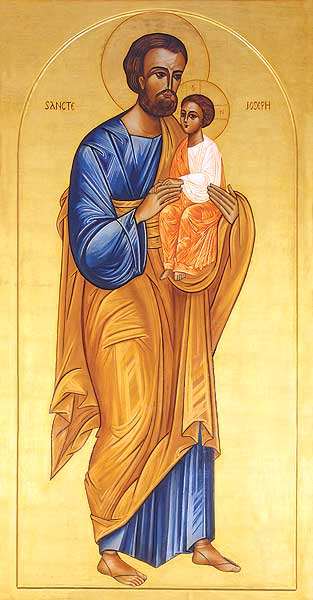
Greeting cards - St Joseph and the Christ Child
Regular price
$1.95
Sale
Inside Text:
Blank inside.Bible Verse:
Matthew 2:21Then Joseph got up, took the child and his mother, and went to the land of Israel.
Item Details:
Our community commissioned this icon from Sister Marie-Paul to occupy the head of the left aisle in our Abbey Basilica. Devotion to Saint Joseph has always been strong among the monks of Conception Abbey. The example he set of faithful service and labor dovetails with the Benedictine model of “ora et labora" ("pray and work").
Icon greeting cards are single-fold cards printed on heavy stock, 4.38" x 5.93". The cards are blank inside for your own message or custom imprint and have an explanation of the history and symbolism of the icon printed on the back.
Image Origins
Upon the occasion of the renewal of our Abbey church, the Basilica of the Immaculate Conception, our community commissioned a beautiful pair of icons from Sister Marie-Paul to grace the head of the side aisles. This one is a full-length image of Saint Joseph holding the Christ Child. The other is of Saint Benedict, the founder of the Benedictine order. Saint Joseph almost never appears in ancient Byzantine icons. He may be seen playing minor roles in icons of the Nativity and of the Presentation in the Temple. Devotion to Saint Joseph gained momentum among European Christians in the beginning in the twelfth century through the work of influential saints like Bernard, Thomas Aquinas, and Gertrude. Since traditional icon outlines are lacking, the icon we have reproduced for you here is an original composition by Sister Marie-Paul following ancient iconographic concepts. The Gospels of Matthew and Luke give us very few facts about Saint Joseph. We are told that he was descended from King David [Matthew 1:6-16], a resident of Nazareth, and a “carpenter.” [Matthew 13:55] We know nothing of his age at the birth of Christ from the Bible, although we can be fairly certain that he died before Jesus began his public ministry, since he is absent from any of the recorded scenes of that period. Further, in John’s Gospel we read that Mary was given into John’s care by Jesus from the cross [John 19:26-7]. Popular devotion to Saint Joseph, especially among working class people, was extremely strong in the nineteenth century and continues today. Pope Pius IX declared Saint Joseph to be the patron of the Catholic Church in 1870. Saint Joseph is also considered to be the patron of fathers, the dying, social justice, and all workers. The Church observes two feast days in his honor, March 19 as the Husband of Mary, and May 1 as Joseph the Worker. Devotion to Saint Joseph has always been strong among the monks of Conception Abbey. The example he set of faithful service and labor fits very well with the Benedictine model of “ora et labora” (“pray and work”). This little prayer expresses it well: “Pray that I will imitate your quiet strength, your diligence in work, your devoted love of the family.”
Theology and Symbolism
Both Jesus and Joseph are garbed in the tunic and robe of the ancient Greek and Roman eras. Jesus’ tunic is white, symbolic of purity and membership in the Christian church, while His robe is crimson and gold, the colors used to symbolize royalty in Byzantine icons. Halos of sanctity surround their heads. The Christ Child’s halo includes a cross and the Greek letters omega, omicron and nu, spelling “HO ON.” In English, this becomes “Who Am,” the name used for God in Exodus 3:14. Each halo is outlined in blood red, and the Latin letters on the background are the same color. Red is a sign of the Covenant, the blood of life shared between God and humankind. The background of the icon is gold leaf. Gold has traditionally been used to symbolize Divine light because the metallic surface reflects and enriches the light that strikes it in a manner so much different from that of paint. Joseph cradles the young Jesus in his arms, enfolding and protecting the Child, but not embracing Him. The pose looks primitive and artificial, iconographic symbolism clearly taking precedence over realism. Joseph’s hands do not touch the Holy Child, though Jesus’ hands grasp Joseph’s as though seeking reassurance or to reassure. Jesus sits enthroned on Joseph’s arm, the King of the Universe made manifest.
